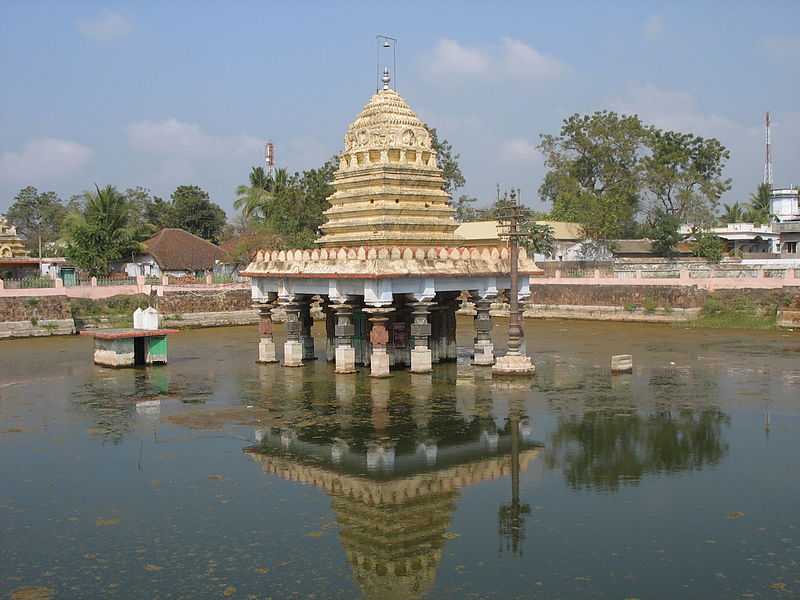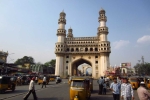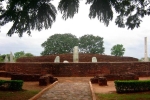Guntur Tourism
Guntur houses the newly coined Andhra Capital of Amravathi, which lies about 30 km away. It serves as the administrative headquarters of Guntur district and has some unique distinctions to its name, having the largest chilli market yard in Asia being one of them. Guntur is also the third most populous town in Andhra Pradesh. With a busy industrial activity scenario, it forms part of the prominent Vishakhapatnam-Guntur Industrial corridor. It lies on the banks of River Krishna which melts into the sea further along the way. The city takes credit for housing the only Buddhist pilgrimage in South India which is situated in Amravathi.
The city displays plethora of captivating relics of its past including Amravati Caves,Nagarjunakondaand many more. Also renowned as textile hub and transport hub of India, it is a center of learning as well. Once being the home to numerous great dynasties, today this city is more known for its industrial growth and exports of chili products to various parts of the globe. An ideal place for history lovers, Guntur was once occupied by several mighty rulers and today promises to take you back once again to the excursion trip of its glorious past.
Download Guntur PDF Guide >
What's Great?
Amazing ambience. Beautiful architectural and historic structures.
What's not so Great?
Narrow and crowded roads. Poor infrastructure.
For Whom
Guntur is for the architecture enthusiasts and history buffs. Also perfect for people living in the nearby places in Andhra Pradesh and Telangana.
Etymology
The earliest known reference to Guntur was made in the Idern Plates of Ammaraja I, a Vengi Chalukyan king who ruled from 922 to 929 CE.
Historically, Guntur was referred as Garthapuri or Guntlapuri which means a city surrounded by ponds. Guntla is the Tamil name for ponds and the word Guntla Uru translates to the pond village. The present name is said to have been come about as a variation of these names referring to the city?s existence near water ponds.
Another story relates the name of Guntur to Kunta, a measuring unit and it is said that the words Kunta Uru later got loosely translated to Guntur and that is how the city got its name.
History
The second oldest evidence of human civilization is present in Guntur in the form of paleolithic tools and implements. The history of Guntur can be traced back to the time of Sala Kings who reigned during 5th Century BC.
Gautam Buddha is said to have preached at Dharanikota/Dhanyakatakam, a place near Guntur. This is where he also conducted the Kalachakra ceremony and this is how Guntur achieved immense significance in Buddhist culture. Buddhists also established universities in the neighbouring regions of Amravati and Dhanyakatakam and this is where the rich academic atmosphere culture and history of Guntur finds its origin.
The famous battle of Palnadu, commonly known as Palnati Yuddham was fought here in 1180 and various dynasties have ruled Guntur over the years including the Satavahanas, Andhra Ikshvakus, Pallavas, Ananda Gotrikas, Vishnukundina, Kota Vamsa, Chalukyas, Cholas, Kakatiyas, Vijayanagara and Qutb Shahis.
Mughal emperor Aurangzeb conquered Golconda in 1687. Guntur was part of Golconda back then and this is how it was annexed to the Mughal Empire.
It also witnessed French occupation for a brief period and in 1783, nearby regions were brought under the reign of Raja Vasireddy Venkatadri Nayudu between 1783-1816 who is credited for constructing multiple temples in the city.
Guntur was later captured by the East India Company in 1788 and became part of the Madras Presidency.
It formed part of the newly formed State of Andhra Pradesh in 1953 after 11 districts of Madras were combined to form a separate State.
Culture
Ask anyone who has lived or grown up in Guntur and they will have an entire list of things to say about Guntur and its culture. One trait peculiar to Guntur is its perfect blend of urban and rural culture.
Guntur has a proud artistic culture and the famously witty and humorous Tenali Ramakrishna, known by the name of Tenali Raman in popular culture also hailed from Guntur. Well known poet Tikkana Somaayaji who translated the entire Mahabharata from Sanskrit to Telugu lived in Guntur as well. When it comes to Telugu, it is the most widely spoken language in Guntur. The version of Telugu spoken in Guntur is pure, without any slang and this is the version we hear in Telugu movies. Guntur is credited for being the Mother of Telugu Film Industry.
Apart from movies and art, residents of Guntur love music and dancing. Carnatic music and Kuchipudi dance form is vastly popular here. Chindu, Dhimsa, and Lambadi are other popular forms of folk dance.
Popular festivals like Diwali, Sankranti Eid, Ram Navami, Shiv Ratri, Vijaya Dasami, Ramadan and Gurpurab are celebrated with great fervour and local festivals like Ugaadi, Krishna-Ashtami, Vinayaka Chaviti, Ekadasi and Karthika Poornima bring about cycles of joy, music, enthusiasm, spelndour, and dance in lives of local residents. The 30th International Kalachakra festival was also concluded in Amravathi.
History of Guntur
The city of Guntur is one of the oldest municipalities constituted in the year 1866. During the middle of the 8th century, the French founded the city of Guntur. However, in 1788 Guntur was ceded permanently to the British. The old residential and commercial structures present here have hints of both French and British architectural styles.
One Day Itinerary
Guntur is the city which offers several places of interest when it comes to the historic monument and religious places. To begin your trip in Guntur, get up early with a delicious breakfast at the hotel. Next, make a list of all the important places you can visit in a day. Amaravathi, Mangalagiri, Krishna Barrage, Uppalapadu Nature Conservation, Kondaveedu and Downtown are the most popular places you will love to explore. Make sure you do take a break and try out the delicious Mirchi bhaji and other local delicacies of the city. One day in this beautiful city is enough to fascinate you and charm you with its relics.
Restaurants and Local Food in Guntur
Andhra Pradesh is the rice bowl of India and naturally, rice is the staple food in Guntur. Andhra cuisine is spicy in general and the food in Guntur is particularly known for its spicy flavour profile. The spiciness is inherent in Guntur cuisine considering the fact that Guntur Sannam, an extremely hot variety of Chili is grown here.
Guntur Kodi Dosa stays true to the spicy nature of cuisine here and is a fluffy, Ghee laden version of regular dosa. Another spicy staple is the Mirapakay Baji which is long green chilli stuffed full of lemon juice and spices, covered with gram flour and then deep fried.
The silken, melt in your mouth Idlis covered with Guntur chilli powder are another tourist favourite here. Sweet dishes also make ample use of rice and rice products. Payasam, Ariselu, and Pootharekelu are rice-based desserts. Bobbatalu is another popular dessert which makes use of sweetened lentil mixture stuffed inside a maida chapati.
Kaja, another commonly available sweet dish is a syrupy dessert made with flour and sugar. Mamidi Tandra is a popular variety of Aam Papad which is made layer by layer over the period of one month and has a unique chewy texture because of the way it is made.
View 2 Restaurants in Guntur >>
Oct-Maris the best time to visit Guntur
Guntur lying around 60 km from Bay of Bengal experiences hot and humid summers which get quite stuffy after the rain. It is not recommended as the best time to visit the city. Winters in the area are mildly cool and pleasant enough to explore its hidden treasures. Thus, the time period between October and March is recommended as the ideal time to visit Guntur.
Weather in Guntur
Loading...
Guntur in Summer (March - June)
The summers in Guntur are hot and generally avoided by the tourists. The temperatures range between 22-39 degrees Celsius.
Guntur in Monsoon (July - September)
Guntur experiences moderate rainfall. It is not a bad time to visit the place. If you do, packing light cotton wear should suffice.
Guntur in Winter (October - March)
The weather is pleasant during these months and the temperature ranges between a comfortable 16 to 25 degrees Celsius. This is the best time to visit Guntur.
Monthly Weather in Guntur
Month
Avg. Minimum (°C)
Avg. Maximum (°C)
January
21
30
February
21
33
March
25
36
April
28
38
May
29
40
June
27
36
July
27
34
August
27
35
September
26
32
October
25
33
November
22
32
December
21
31
Comments on Guntur
Post Your Comment


 Nagarjuna Sagar Dam and Ethipothala Falls
Nagarjuna Sagar Dam and Ethipothala Falls Kondaveedu
Kondaveedu Kotappakonda Trikutaparvattam
Kotappakonda Trikutaparvattam Uppalapadu Nature Conservation
Uppalapadu Nature Conservation Vijayawada
Vijayawada Amaravathi
Amaravathi Machilipatnam
Machilipatnam Papikondalu
Papikondalu Hyderabad
Hyderabad Nagarjunakonda
Nagarjunakonda